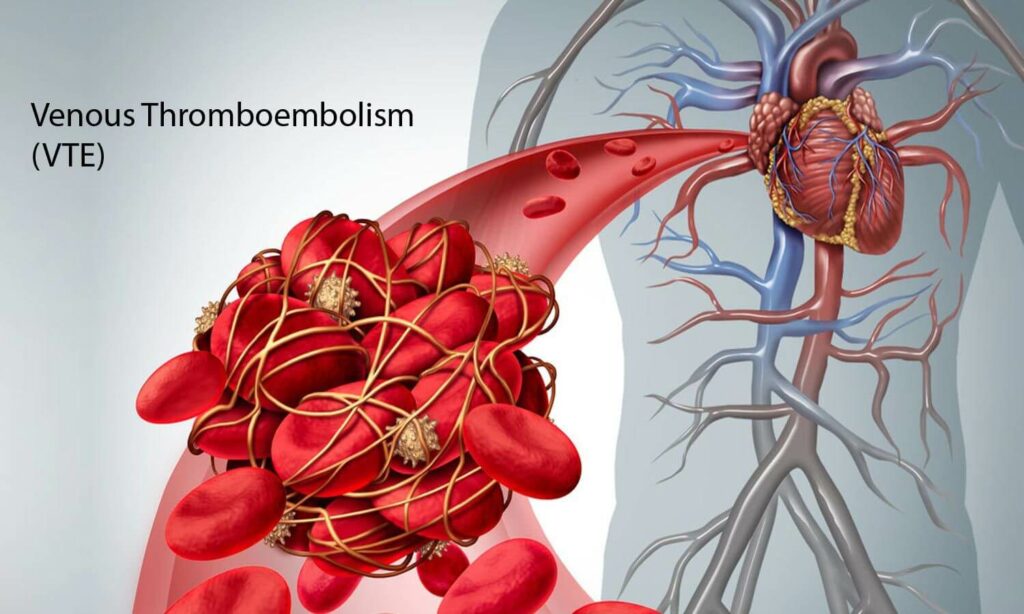PADUA Score Calculator is a medical tool used to evaluate the venous thromboembolism (VTE) risk factors of particular patients and eventually gives you a report on whether it’s recommended to use pharmacological prophylaxis in the treatment.
For an in-depth review of our calculator’s features and functionality, don’t forget to read through the text below and inform yourself of the things you haven’t known before. So, would you like to check out more calculators on a variety of topics? – if you are interested in food and health, check out our health or food category.
What is Venous Thromboembolism?

In medicine, venous thromboembolism, or so-called VTE, is defined as a medical vascular diagnosis (blood clot) that starts and can be found in a vein. Thus, after a stroke and heart attack, this diagnosis is ranked the third most leading one that over half a million Americans experience every year. However, VTE is not a narrow term, and medicine classifies it into two categories:
- Deep vein thrombosis (DVT), and
- Pulmonary embolism (PE)
These categories of venous thromboembolism can be cured if you take immediate action and hospitalize patients.
What are the Symptoms of Venous Thromboembolism?
Okay, you grasped now everything you need to know about VTE, in general. But, what are its symptoms and the clear signs that warn you and make you go to a doctor to check and diagnose it? What does study say?
DVT mainly affects the larger veins in the lower parts of the leg and thigh, and the clot prevents the blood from flowing in the individual’s body and can cause:
- Leg pain or tenderness of the thigh or calf
- Leg swelling
- Skin that feels warm to the touch
- Red streaks
PE is more dangerous when it attacks the body because it can block all or most of the blood supply channels that carry the blood to the lungs. Lack of blood in the lungs can cause serious health issues, such as:
- Shortness of breath
- Fast breathing
- Constant chest pain
- An enormous increase in heart rate
- Passing out
Methods for VTE Risk Assessment
There are numerous ways and methods to analyze and measure VTE risk. On some occasions, you can even build and utilize your own medical prediction assessment tool for VTE risk, but it is recommended to choose the most popular and trustful DVT/VTE tools in the industry.
The regular VTE risk assessment can start as low as testing clotting activity with a D-dimer test that may reveal early signs and symptoms of DVT. After the D-dimer test, you should also utilize the ultrasound compression testing designed to reveal a formed thrombus effectively.
But, what are the recommended DVT/VTE assessment tools in the industry?
For pulmonary embolism (PE):
- Revised Geneva score
- Wells score
For venous thromboembolism (VTE):
- Padua score
- Caprini score
PADUA Score – What is it used for?
PADUA score is a prediction score you get after previously checking the risk factors for VTE on patients. After going through each risk factor, you analyze and grade the patient’s state with a certain number of points. The sum of all the points makes the PADUA prediction score or clinical judgment which reports you the VTE of a patient and determines whether the clinical use of pharmacological prophylaxis for the patient is recommended, additionally.
PADUA Score Formula
The formula for generating the PADUA prediction score for a patient is the sum of all the score risk variables:
PADUA score = Age + Obesity + Reduced mobility + Hormonal treatment + Active cancer + Trauma/surgery + Previous VTE + Thrombophilic condition + Failure + Myocardial infraction + Infection
PADUA Score Variables
Each assessment for VTE risk involves the check of the following items/variables. Each variable holds a certain number of points which ultimately gives the values for the PADUA score.
| Padua variable | Yes | No |
| Age ≥ 70 years | 1 | 0 |
| Obesity (≥30) | 1 | 0 |
| Reduced mobility | 3 | 0 |
| Hormonal treatment | 1 | 0 |
| Active cancer | 3 | 0 |
| Trauma/surgery (≤ 1 month) | 2 | 0 |
| History of VTE | 3 | 0 |
| Thrombophilic condition | 3 | 0 |
| Heart/respiratory failure | 1 | 0 |
| MI/stroke | 1 | 0 |
| Infection/rheumathologic disease | 1 | 0 |
PADUA Score Interpretation
When you analyze the patients for VTE risk, and you get the PADUA score, the question arises, “What does this number mean, and how can we understand it?”.
There are two important interpretations:
- PADUA Score ≥ 4 points – Our PADUA Score Calculator will tell you:
Pharmacological prevention is not recommended.
Use mechanical VTE prophylaxis, such as:
- Compression stockings, or
- Intermittent pneumatic compression devices.
- PADUA Score < 4 points – Our PADUA Score Calculator will tell you:
Pharmacological prophylaxis is indicated in this particular case. Apply the guideline-based anticoagulation, such as:
- Low molecular weight heparin (LMWH)
- Vitamin K antagonists, or
- Direct oral anticoagulants (DOACs)
In case of a high risk of bleeding, consider mechanical VTE prophylaxis.
What is VTE prophylaxis?
Study reports that thromboprophylaxis is the number one safety medical strategy for hospitalized patients. However, only 60-70% of patients receive an adequate VTE prophylaxis.

VTE prophylaxis is a safety method with a combination of pharmacologic:
- Low molecular weight heparin or unfractionated heparin
- Vitamin K antagonists
- Direct oral anticoagulants (DOACs)
- Aspirin (only in combination with another drug)
and nonpharmacologic (mechanical) measures:
- Compression stockings
- Intermittent pneumatic compression devices
- Calf exercise
- Early ambulation after surgery
that reduce the risk of deep vein thrombosis and pulmonary embolism.
PADUA Score Calculator – How to Use?
The quickest and most effective way to calculate the Padua prediction and clinical judgment score and check VTE risk is to utilize our PADUA score calculator. But, how do we utilize it?
Steps:
- Check if the patient is >= 70 years old
- Does the patient have a BMI score >= 30
- Check if the patient’s mobility has been reduced
- See if the patient is under ongoing hormonal treatment (hormone replacement therapy or oral contraceptive pills)
- Does the patient suffers from an active (ongoing) cancer (Yes / No)
- Did the patient have any trauma or surgery within the last month
- Check the history of venous thrombosis and thrombophilic condition
- Check if the patient suffers from heart failure, myocardial infarction, or acute infection
- Answer each of these questions by “yes” or “no”
- Our calculator will grade your answers by respective points and give you the PADUA score.
PADUA Score Calculator – Example
The easiest way to understand something fully is through an example. Therefore, in this part, we will make up a scenario and apply our calculator to measure the PADUA prediction score and see if there is a need for Pharmacological prophylaxis.
Scenario: There is a hospitalized patient (60 years of age), and you want to analyze the risk of VTE.
Steps:
- The patient is 60 years old: +0 points
- Obesity: +1 points
- Reduced mobility: +3 points
- Hormonal treatment: +0 points
- Active cancer: +0 points
- Trauma/surgery (≤ 1 month): +2 points
- History of VTE: +0 points
- Thrombophilic condition: +0 points
- Heart/respiratory failure: +0 points
- MI/stroke: +0 points
- Infection/rheumathologic disease: +1 points
Total Padua score: 7 Points
- Pharmacological prophylaxis is indicated in this particular case.
FAQ
When do you need VTE prophylaxis?
For hospitalized patients with the Padua score greater or equal to 4, you should use pharmacological prophylaxis.
Based on your patient’s condition, you should also include guideline-based anticoagulation, such as:
- Low molecular weight heparin
- DOAC(s)
– Vitamin K
What is the PADUA score used for?
PADUA score is a medical, clinical prediction score you get after previously checking the risk factors for VTE on a patient. It reports you the VTE of a patient and determines whether you should use pharmacological prophylaxis for the patient additionally.
What causes venous thromboembolism?
Study shows that these factors mainly cause venous thromboembolism (VTE), but there are more of them:
– surgery
– cancer
– immobilization
– hospitalization
– oral contraceptives or estrogen
– pregnancy
– obese or overweight people
– people who have thicker blood
– VTE hits older people more often than the younger population
What is a Caprini score?
Originally published and released in 1991, the Caprini score was designed as a tool to analyze and assess the risk for venous thromboembolism (VTE).
What is the difference between a DVT and a VTE?
VTE or venous thromboembolism is one of the world’s top leading medical vascular diagnoses. It represents the blood clot that starts its journey in an individual’s veins. On the other hand, DVT or deep vein thrombosis is just a category of VTE, the clot that blocks the blood from flowing and reaching other parts of the body.
